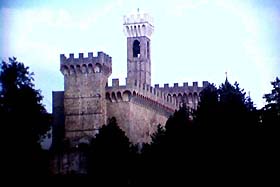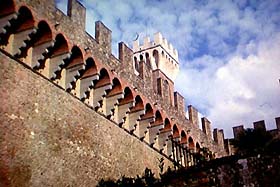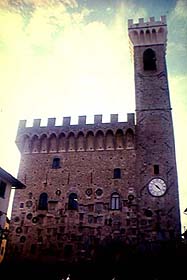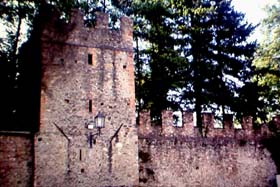Scarperia Castle
 |
 |
Scarperia rises in the heart of the Mugello on the Bolognese Road.
Click here for the Map or here for More Photos
The area (known as 'Mugello', part of northeast Tuscany between Florence and the Apennines) where Scarperia stands once stood Etruscan settlements, and in Roman times two important roads served the area crossing over two different mountain passes: the 'Faentina' to east and the 'Bolognese', that crossed the mountain pass of the 'Futa', to west. During the Middle Ages another important road opened a new line of communication, called 'S.Agata' but today is reduced to a mule-track. It had become one of the most important roads linking Florence to Bologna and northern Italy.
 |
|
The internal facade
|
At the beginning of the 14th century the Florentine Republic decided, in order to better control these routes, to build two new fortified towns, at that time called 'New Lands': the first was Scarperia in the 'Mugello' and the second Firenzuola (Little Florence), on the opposite side of the Apennines mountain. The Mugello was, since the High Middle Ages, a fief of the Ubaldini family. The Florentine Republic had to destroy one of their strongholds, the castle of Montaccianico, before beginning in 1306 the construction of a castle on the place called 'the Scarperia'. The new fortification was called 'Saint Barnaba Castle' but soon became known with the ancient name of the place. Its main role was to prevent a rebirth of the Ubaldini family's ambitions of power and for this aim also the other castles of the zone - Ascianello, Lago, Lomena and Cerliano - were leveled.
The planning of this 'New Land' was entrusted to the great architect Andrea Pisano, at the time engaged also in the works at the Florence Cathedral. It is likely he took part only in the building of the Palace-Fortress, seat of the Vicarious. The castle became the most important of the north-east Tuscany, and Florence allowed the use at Scarperia of its coat-of-arms with the lily. The Bolongnese road divided Scarperia in half, and today still forms the the main axis of the town. Scarperia has an irregular shape similar to a rectangle, encircled by walls, bristling with Guelphs battlements and square towers.
 |
|
The town walls
|
The core of the stronghold is the so called Public Palace or Palace-Fortress: a classic and austere residence on the inner facade - towards the main square of the town - fortress in the rear, joined by two great walls curtains, endowed with machicoulis, which forms an immense inner courtyard, to the keep, inserted on the western line of the town-walls. The palace complex, also called 'of the Vicarious' includes at the base inclined walls and of a high tower coming out from the right angle of the inner front. The facade is also adorned by an incredible number of coats of arms of the Florentine Vicarious. The inside courtyard is characterized from furnishings and frescoes of the 15/16th centuries that contrasts with its the rude external aspect.
The importance of Scarperia as a market and control center on the Bolognese Road remained unchanged until 1762, when the regining Lorena re-opened the mountain pass of the Futa, the fastest way to reach the other side of the Apennines, and so began the decline of the ancient 'Saint Barnaba Castle'. The Palace of the Vicarious is freely visitable and has been recently an object of important works of restoration.
| More Photos |
| View a Map |
| Back to Homepage |
| Back to Castles Index |